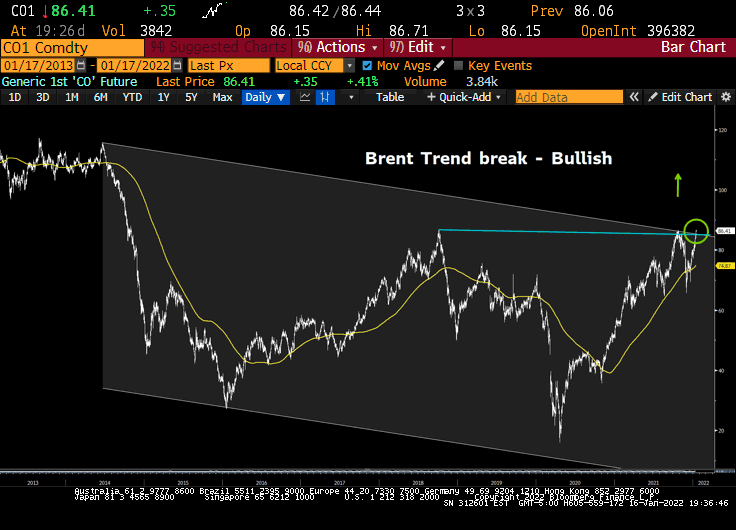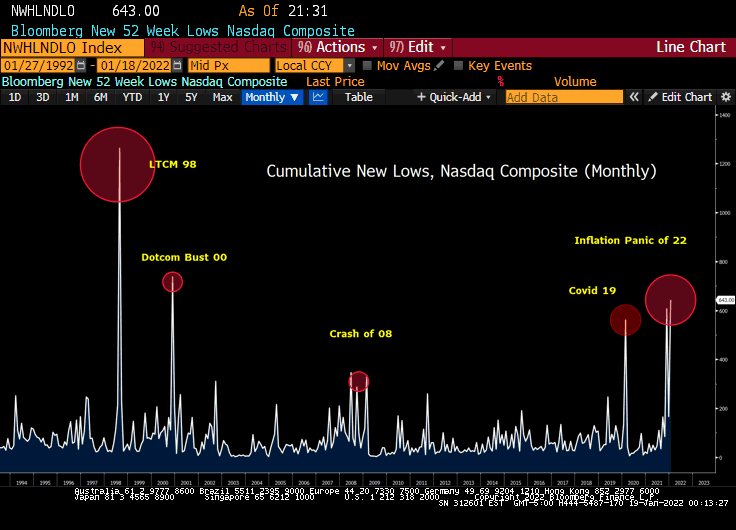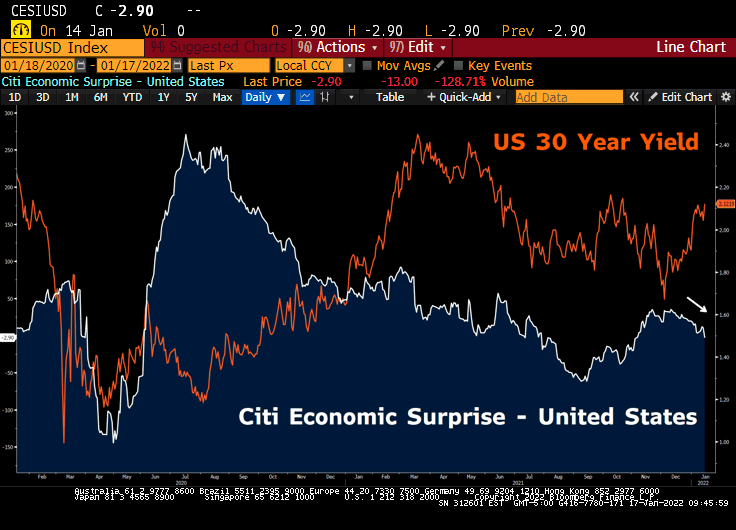Institutional investors can join our live chat on Bloomberg, a groundbreaking venue, just email tatiana@thebeartrapsreport.com – Thank you.
Lawrence McDonald is the New York Times Bestselling Author of “A Colossal Failure of Common Sense” – The Lehman Brothers Inside Story – one of the best-selling business books in the world, now published in 12 languages – ranked a top 20 all-time at the CFA Institute.
“By their fruits, you will know them. Do men gather grapes of thorns or figs of thistles?” —Jesus Christ, in his Sermon on the Mount as related in Matthew, a warning against false prophets.
Up More than 10% Year to Date, 33% from Omicron Fears on Dec1
 A Large Tax on the middle class – energy prices. Goldman is now calling for $100 crude by August. Large implications on inflation looking forward.
A Large Tax on the middle class – energy prices. Goldman is now calling for $100 crude by August. Large implications on inflation looking forward.
The Shock
For the last available data week, money borrowed via reverse repo increased $66.4 billion while the Fed’s balance sheet increased another $22.6 billion. Back in Volcker’s day, that would have been considered a massive liquidity injection, and quite inflationary. You see, back in 1980, there was this thing called “the Volcker Shock” which involved increasing the Federal Funds Rate to the highest it has ever been. Such a dramatic move convinced everyone that he had the courage to kill inflation. He drained money from the system. He didn’t inject money into it! Volcker believed once inflation oozes into a million corners of the economy, it cannot be stopped with small – incremental rate hikes – you MUST go big to kill it.
Killing Inflation Comes with a Price
 Killing inflation comes with a high price, on a cumulative basis – Nasdaq’s new lows are epic.
Killing inflation comes with a high price, on a cumulative basis – Nasdaq’s new lows are epic.
Just as false prophets do not produce good fruits, so too do false inflation fighters fail to use a Volcker Shock. One should not judge prophets, and Central Banks, only by their words.
*Paul Adolph Volcker Jr. – He served two terms as the 12th Chair of the Federal Reserve from 1979 to 1987. He was nominated to position by President Jimmy Carter and renominated by President Ronald Reagan. He was widely credited with having ended the high levels of inflation seen in the United States during the 1970s and early 1980s.
Markets Pricing Four Moves in 2022 – Now What?
The continued strong inflation has led to both a Fed pivot on inflation and markets now pricing in four 25bp moves this year, 160bp by December of 2023, and only 10bp more by December of 2024. With “transitory” officially retired at Powell’s September FOMC press conference, the main issue for investors is whether the Fed will meet the priced targets, undershoot or overshoot. In the 2015-2016 rate hiking cycle kickoff, they promised 8 moves to start and only delivered two over 24 months.
The Inflation Pivot
When we were on the trading floor at Lehman in Q4 2006. At that point, as the clock struck midnight on a frosty evening in December, we gathered the courage to pitch a colossal short on the US housing sector (Beazer, Countrywide, New Century – credit and equities). We pitched the trade into Mike Gelband (Global Head of Fixed Income) and Alex Kirk (COO of Fixed Income). Both approved the SIZE short – but said. “Make sure you run it by our economics team.” Before breakfast, the academic brain trusts – NONE of whom had EVER actually sat in a risk-taking seat – refused to endorse the trade. “Every model we believe in tells us housing will NOT decline on a national level with unemployment at these levels, it´s just NOT possible (historically, more people were working than ever before).” Gelband and Kirk approved the trade anyway, they said – “make sure you double it – 2x the size proposed.” Legends.
(This story is laid out in our New York Times Bestselling book – “A Colossal Failure of Common Sense” – The Lehman Brothers Inside Story – one of the best-selling business reads in the world, now published in 12 languages – ranked a top 20 all-time at the CFA Institute.)
The Fiscal and Monetary Response
Covid Crisis
$2.2T CARES Act, Q2 2020
$0.9T Aid package, Q4 2020
$1.9T American Rescue Plan, Q1 2021
$1.0T Infrastructure, Q4 2021
$4.0T Fed asset purchases
$10.0T
Post Lehman´s Failure
$0.7T Tarp Relief
$1.1T Fed asset purchases
$1.8T
FAILED Fed Economic Models Come with a High Price – Even in the face of this fiscal and monetary response differential – this cycle vs. last, the Fed models saw NO RISK OF SUSTAINED inflation six months ago. Economic models were focused on premature deaths, reduced immigration, forgone capital investment, the economic costs of lockdowns on unemployment, pandemic induced exits from the labor force. The Fed was too focused on demand, NOT supply. For example, ESG’s impact on oil, coal, and gas exploration – a $1T + hit to capex – has had a colossal impact on the cost of energy.
Back To Powell´s Change of Heart
Whether it was the continued release of strong inflation data or the realization of his reappointment, Chairman Powell exhibited a definite shift towards controlling inflation following the November 22 reappointment announcement. In Congressional testimony on November 30, he said it is a “good time to retire the term transitory.” At the press conference following the December 15 meeting, he stated “There’s a real risk now, I believe, that inflation may be more persistent and…the risk of higher inflation becoming entrenched has increased” … “That’s part of the reason behind our move today, is to put ourselves in a position to be able to deal with that risk.” This past week he stated, “If we have to raise interest rates more over time, we will.” He also said, “we need to focus on inflation a little bit more at the moment than the maximum employment goal.” With the unemployment rate back under 4%, that seems a good bet. While the past two nonfarm employment figures have been less than expected, the Household survey, which feeds into the unemployment rate, showed increases of 651 thousand and 1.09 million respectively.
US 30 Year Treasury Bond Yield vs. the Data
Up from 167bps to 212bps since early December
ISM Man 58.7 vs 60.0 exp Jan 4 (miss)
ISM Svs 62.0 vs 67.0 exp Jan 6 (miss)
Jobs NFP 199k vs 450k exp Jan 7 (miss)
AHE 4.7% vs 4.2 YOY exp Jan 7**
CPI 0.5% vs 0.4% exp MoM on Jan 12**
Retail sales -1.9% vs -0.1% MoM exp on Jan 14 (misss)
Industrial Production -0.1% vs +0.2% MoM exp Jan 14 (miss)
UMich 68.8 vs 70.0 exp on Jan 14 (miss)
**hot wage – inflation data
Rates and Economic Data
 Economic data in the USA is rolling over, meaningfully. Inflation is already hiking rates for the Fed – very aggressively – where is the trade? Reach out to tatiana@thebeartrapsreport.com.
Economic data in the USA is rolling over, meaningfully. Inflation is already hiking rates for the Fed – very aggressively – where is the trade? Reach out to tatiana@thebeartrapsreport.com.
“It really depends on any crisis signal from stocks. A 25% one-day crash in US equities would halt the Fed in its tracks. A 25% decline of 2-ish percent a month over 12 months or so may not alter Fed behavior. Just because the Fed doesn’t like crashes doesn’t mean it can’t deal with slow grind declines. It is all about financial conditions” – Hedge Fund CIO in our Live Chat on Bloomberg.
Fed pricing reflects a steady tightening path in 2022 and 2023 with a terminal fed funds rate of around 1.75%. Note this is lower than the previous peak in fed funds of 2.50% in 2018/2019 and may prove to be low, indeed. By comparison, CPI was just 1.9% at the end of 2018 vs 7.0% today.
A number of Fed Presidents (Bullard, Mester, Harker, Bostic, Daly, George) have mentioned the possible need to raise rates in March and the possibility of four rate increases this year is also becoming more prevalent, matching market pricing. The surprise would be if the Fed tightens by 50bp or skips moving at a quarterly meeting. With Mester, George, and Bullard voting this year, the FOMC will have a more hawkish slant.
Balance sheet adjustment is also a discussion point, with some estimates it could come as early as June and certainly this year. A reduction in the balance sheet could potentially also be implemented in lieu of one tightening.
What Can Delay a Tightening?
At this point, with the Fed widely viewed as behind the curve, it will be difficult to delay the path. Two potential causes would be – 1. a continued uptick in Covid cases or a new, more deadly strain; and 2. a sharp correction in risk assets. With inflation gaining traction, the Fed is in a tricky spot, as they may have to continue tightening even though they don’t want to. As mentioned above, balance sheet reduction may help in this case.
Markets have had a dramatic move so far this year, and the GAMMA Alert (sent to clients) we had at the start of the year worked well. Green March Eurodollars are down 42bp and TYH is down almost three points the past two weeks. Special thanks to Arthur Bass, at Wedbush for his weekly insights.
Don’t miss our next trade idea. Get on the Bear Traps Report Today, click hereInstitutional investors can join our live chat on Bloomberg, a groundbreaking venue, just email tatiana@thebeartrapsreport.com – Thank you.
Lawrence McDonald is the New York Times Bestselling Author of “A Colossal Failure of Common Sense” – The Lehman Brothers Inside Story – one of the best-selling business books in the world, now published in 12 languages – ranked a top 20 all-time at the CFA Institute.


